Taradale Historic Walk

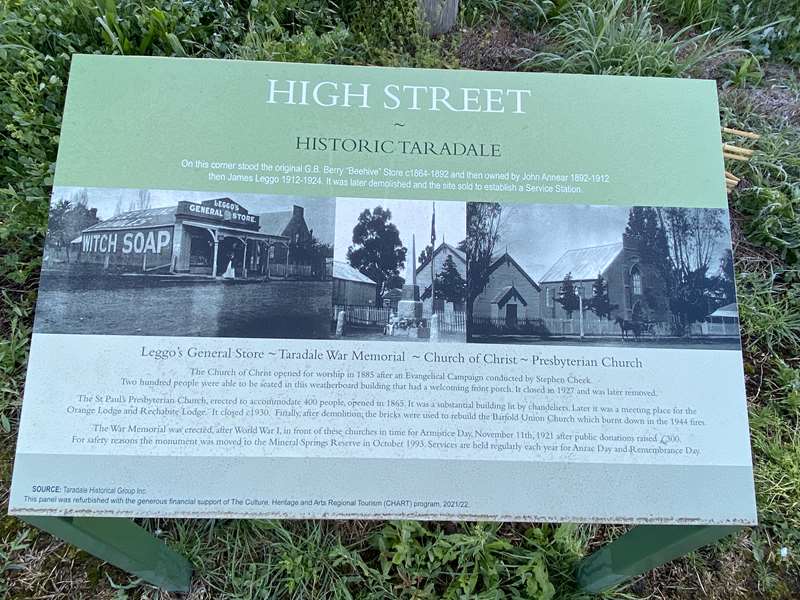
This walk explores the history of Taradale.
EARLY YEARS
Taradale is a small town in Central Victoria nestled in a valley on Back Creek close to its junction with the Coliban River. Major natural attractions include stunning views across hills and valleys, walks on historic designated tracks and an abundance of seasonal wildflowers. The traditional custodians are the Dja Dja Wurrung people. The first non-indigenous people established the Town in the 1840's. The Town was named after the home of geologist Sir Roderick Murchison, Tarradale House in Scotland. On 8th August 1864 Taradale was proclaimed a Borough.
THE GOLD RUSH
Gold was discovered in Victoria in 1850. In 1851 the Victorian Government offered a reward of 200 pounds to anyone finding gold within 200 miles of Melbourne. This led miners to explore Central Victoria. The Gold Rush was to last until the late 1860's. At its peak it is estimated to have attracted an average of 6,000 diggers a week from all over the world to Victoria. The journey from Melbourne to the goldfields was not easy for many after three months at sea. The paths they took were often the same ones that indigenous Victorians had taken for millennia and it was only with indigenous help that some were able to make it to their destinations. "After great difficulty we were happily enabled to complete a bargain with two of the natives, Djadjawurrung guides, to put us upon a track that would lead us to Forest Creek. For this piece of service we would almost have given all the gold we had." (John Sherer, The Gold Finder of Australia, 1853)
A PERIOD OF GROWTH
Taradale grew as the goldfields grew. Primary industry developed hand-in-hand with mining as the rapidly-growing population needed an abundance of food and supplies. Taradale's infrastructure developed quickly. The Taradale Post Office opened on 1st March 1856. The original Mechanics Institute opened in 1860. Taradale Primary School opened in 1855, while the Courthouse was built in 1856 and Taradale Hall in 1860. Taradale's greatest landmark, the Railway Viaduct over Back Creek was constructed between 1858 and 1862. By the 1890's Taradale boasted 23 hotels and 40 liquor licences servicing the 2,000 Europeans and 3.000 Chinese in the Town. High Street was bustling with the merchants needed to supply building materials, explosives, victuals, fodder. food and more.
20TH CENTURY CHANGE As gold petered out, so did the population. Much of Taradale's streetscape was removed in the 1930's. Two storey buildings were demolished for bricks and iron to use in other parts of Victoria. In 2008 the Calder Freeway bypassed Taradale. Some lamented the loss of passing trade, but the opening of the freeway allowed Taradale to thrive in its own right. Taradale now has a population of 500 and offers a busy General Store/ Fuel Station/Post Office plus wine, coffee and art outlets.
A Tour of Taradale

EARLY BUILDINGS IN HIGH STREET
High Street Taradale was a busy trading precinct in the Gold Rush era. Early photographs such as at Pattersons Corner (H1) (i) show many two storey shops and merchants. After WW1, Taradale township gradually went into decline. Because bricks and iron were in short supply at this time, many empty Taradale buildings were dismantled and relocated to other regional townships. Buildings now demolished include: Berry's Beehive Store (1864) on the corner of Roderick St. Next door was the weatherboard Church of Christ. It accommodated 200 people, closed in 1929 and was later demolished. St Paul's Presbyterian Church (1865) seated 400 people.
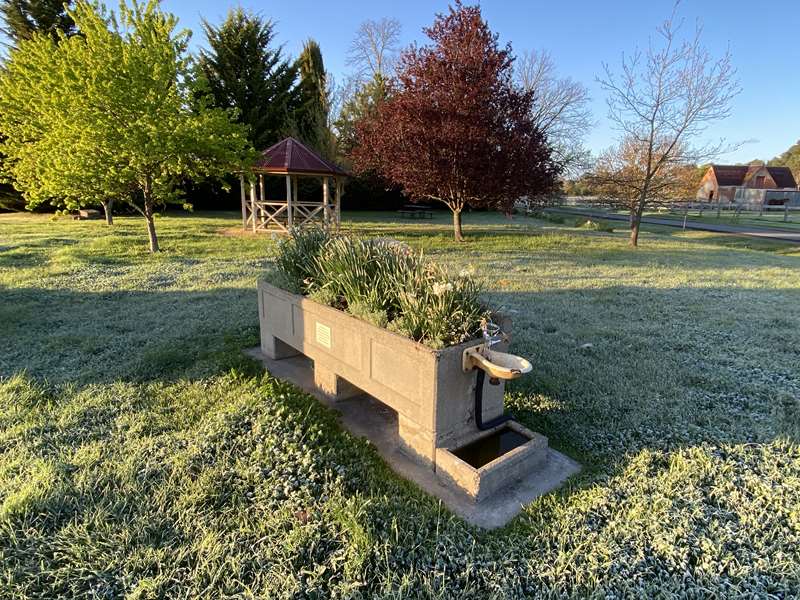
This area now has a grassy triangle with seats, pergola with seats, carved stone from the Presbyterian Church (1860) and a George & Annis Bills Horse trough. George and Annis Bills, formerly of Brighton, England, came to Australia in 1859. They became life members of the RSPCA, formed in 1871 in Melbourne. Wishing to alleviate the inadequate watering facilities for horses, the then mainstay of commercial transportation, George and Annis donated thousands of concrete horse troughs (in some instances with a dog bowl and drinking fountain) to countries around the world. Annis died in 1910 and George in 1927, and left a bequest to continue the provision of horse troughs. The Taradale trough was installed in High Street in 1933 and was relocated to its present position in 1992 after the original location became unsuitable due to the widening of High Street.
The Faraday Street Law and Order Precinct (H2) (i) included the Police Station (later the Water Bailiff's house), the Court House and the Solicitor's House. This became the Mining Registrar's House.
TARADALE POLICE STATION - This site was first used as a Police Station c1865/66 and continued until 1915. Squatters occupied the site until 1922. Then, in 1927, became the Water Bailiff's residence until 1961. In 1963 it was sold for 1200 pounds.
TARADALE COURT HOUSE - The Court House was completed in 1866 of triple brick on a Bluestone foundation overlooking the township, at a cost of 1256 pounds. It was later used as a Polling Booth before becoming a private residence.
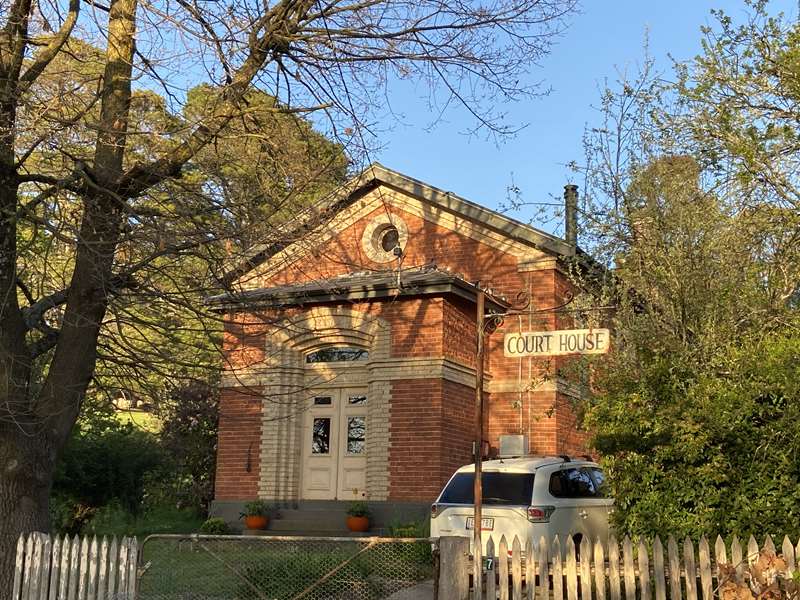
SOLICITORS HOUSE, 1859 - Austin Solicitor's Office which was later used as a Mining Registrar's Office until c1900. The original single-fronted brick building became the home of Miss Annie Mudd and the Picken family. In the 1940s the house was extended into a much larger home.
METHODIST CHURCH, 1865 - The first Methodist Church was built at 'Talbot Hill' in 1857 and opened in October 1859. It was pulled down in 1864, and the bricks (which were manufactured in Taradale) used to build a larger church which opened on 13th August 1865. This is now Clergy Cottage accommodation.
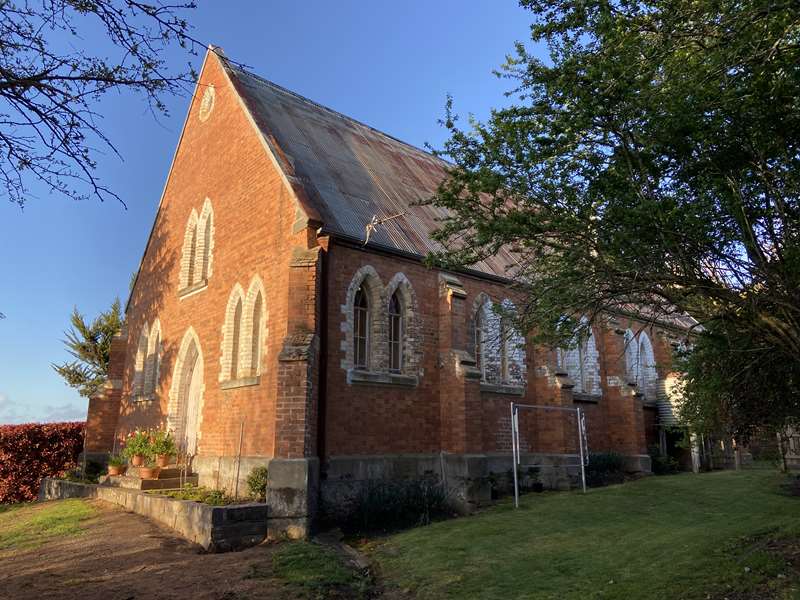
ROMAN CATHOLIC CHURCH, 1890 - Known as St. John the Evangelist (Roderick Street). The Church was consecrated by the Roman Catholic Archbishop Dr. Carr, on November 23rd, 1890. It was constructed with bricks reputed to have come from England as ballast in a sailing ship. A. Catholic School, No. 636, run by Mrs Mary Shearer was also on this site before its demolition c1910. The last Mass was celebrated in 1956 and the Church deconsecrated in 1972 before the building was sold by auction.
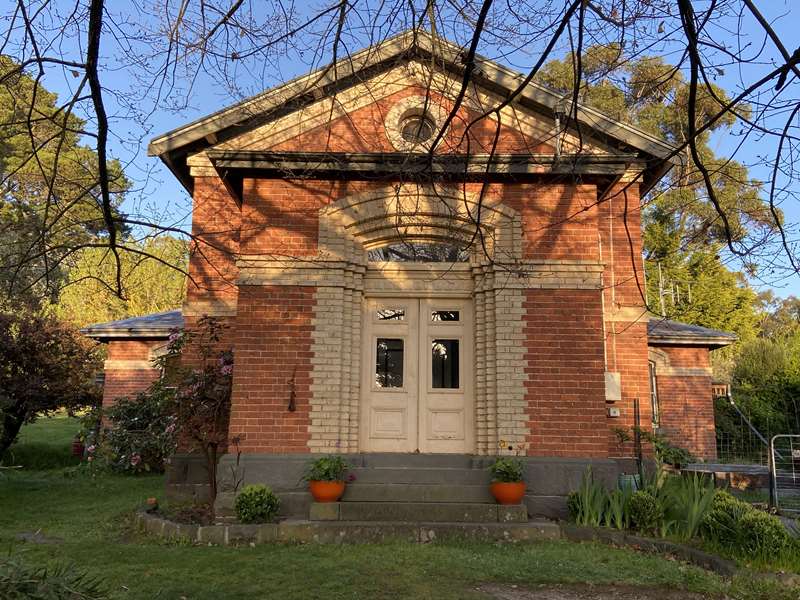
Note: All of the sites listed above are private property, please be respectful of property boundaries.
Dormans Store and Bakery (H3) began trading in 1907. Brothers William Edgar (Ted) and Gifford Stephen (Giffie) owned and managed the business, baking & selling bread, groceries, farming needs and stock feed.
Horsedrawn wagons delivered these goods to Drummond, Malmsbury, Metcalfe, Redesdale, Sutton Grange, Spring Hill, Elphinstone and Taradale. The business grew rapidly into a General Store as the brothers responded to local needs. Cakes, catering, newspapers and magazines were added, and as motor vehicles replaced wagons a petrol bowser was installed. The store sold everything from jewellery to work boots and tools, including wool, haberdashery, homewares, stationery and fruit & vegetables sourced from Castlemaine.
Vagabond bushranger Charles Sanger was captured outside this store on June 21st, 1914 by Constable Alexander Hesford. Sanger appeared in Taradale Court and received a 5 year sentence. He was sent to Bendigo Gaol on 24th June, then a week later transferred to Pentridge.
A total of ten Dorman family members worked in the business, but extra services required additional staff which proved valuable employment for local people. The store traded successfully for forty-seven years until it was sold in 1954 to new owners, then finally closed, and the building was demolished.
The Freemasons Hotel (c1860) was on the corner of Jackson St. It became derelict and was demolished in the 1970's. The National Bank operated from 1859-1922. In later years it became part residence. It burned down in 1991.
The Commercial Hotel (H4) (i) was a busy Cobb and Co change station. Cobb and Co boasted a more comfortable ride than the opposition and took half the time but cost a month's wage. A groom had to prepare five horses for each of the four coaches daily. Note: H1 - H4 denote historic former buildings
1. MECHANICS INSTITUTE (i)
Mechanics Institutes were established across Victoria for the education and recreation of tradesmen. Upon opening in 1862 the current building was known as the Taradale Athenaeum. The words Library and Reading Room were visible in the early photos of the frosted glass windows. By 1882 over 3700 people visited the Mechanics Institute annually. In later years it had other uses such as a polling booth, craft shop, venue for card games, meetings and a workshop. It survived fire in 1927 and was repaired after a motor vehicle impact 1989. The Taradale Historical Group Inc has been located at the Mechanics Institute since 1992. The building was fully restored in 2011.
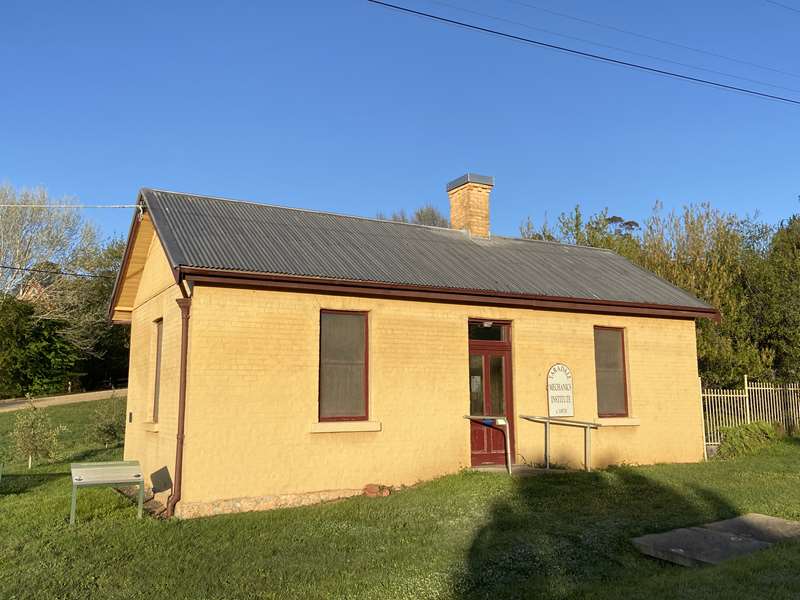
Opposite the Mechanics Institute were two buildings of interest (which are no longer there). The National Bank of Australasia operated from 1859 until 1922. When the gold diggings declined so did the need for banks in Taradale. The building was sold for a private residence to James Leggo in 1917 who owned the Beehive General Store on the adjacent corner. The bank business was operated in the front room whilst the Leggo family lived in the remainder of the building. Unfortunately the building burnt down in 1991.
The Commercial Hotel, originally 'The Dorchester', was one of Taradale's many hotels.
2. FORMER TARADALE POST OFFICE (i)
The Taradale Post and Telegraph Office was built c1861 to accommodate the rapidly-growing communications needs of the Town. By 1870 it was handling 39,000 letters and 17,500 newspapers a year. With this volume of mail it had to move opposite to a two storey bank building (now demolished) until the 1920's, when it reverted back to its original small building, now 120 High St. Note the well-worn stone step on this virtually unchanged building.
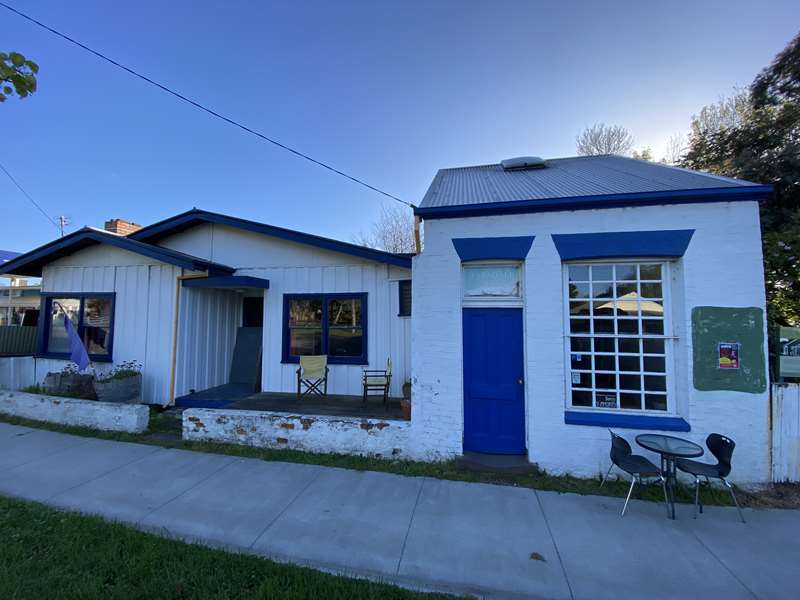
3. TARADALE MINERAL SPRINGS RESERVE
The Mineral Springs Reserve, on Back Creek, is one of Taradale's greatest assets. Gazetted in 1888, it features secluded, leafy areas combined with beautiful open spaces, and a mineral water pump with sodium magnesium bicarbonate water. The Reserve provides toilet facilities, a free, undercover barbecue area and seating throughout the park. The Taradale War Memorial is also located here. A creatively designed children's playground was constructed in 2016 and is a major attraction for local and visiting families. A prominent display board near the pavilion shows the main walking tracks in and around Taradale.
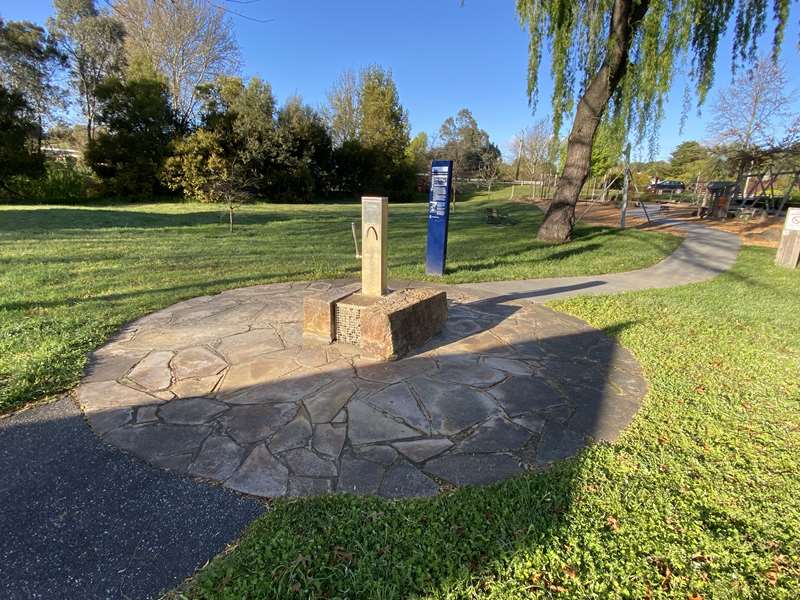
4. TARADALE HALL (i)
The original Oddfellows Hall was built in 1860 with a front door and two windows. Later, as it became a centre of social activities, the building was altered to increase floor space. In 1926 The Golden Age Hotel next door was destroyed by fire causing damage to the Hall. The official 'Switching On" ceremony of electricity in Taradale was at the Hall on June 3rd, 1950. This public building is still serving the community well and has been upgraded in recent years.
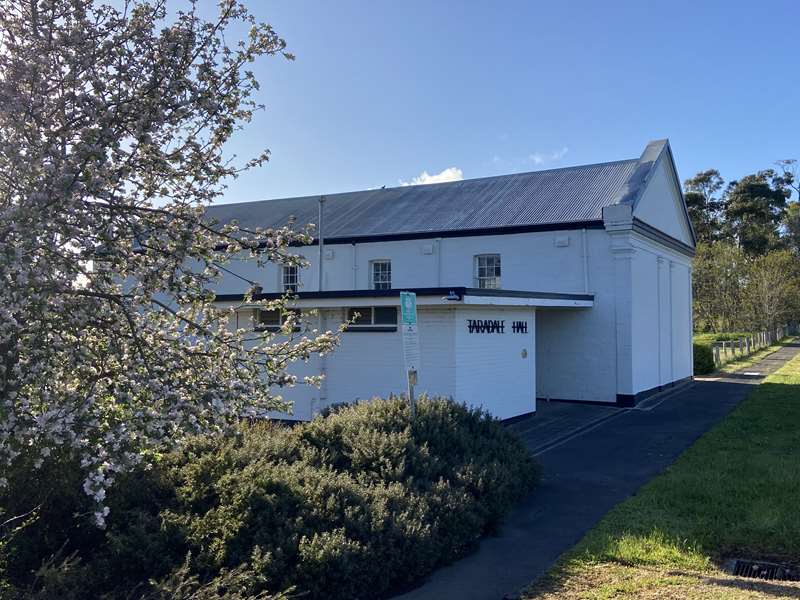
5. TARADALE PRIMARY SCHOOL (i)
The school opened in 1855 with 27 students as a National School built at a cost of 450 pounds. It has operated continuously since, making it one of the oldest schools in Victoria. In 1864 the school was assigned its number, 614. In 1874 the current main building was constructed by the Department of Education to accommodate an increase in students from mining families. Enrolments peaked at 205 in 1877. During this period children as young as two years and eight months old were enrolled. From 1875, night classes were held for male students aged 12-25; predominantly miners. Enrolments fluctuated through the 20th century. Recent years have seen a surge in enrolments with many new families moving to Taradale.
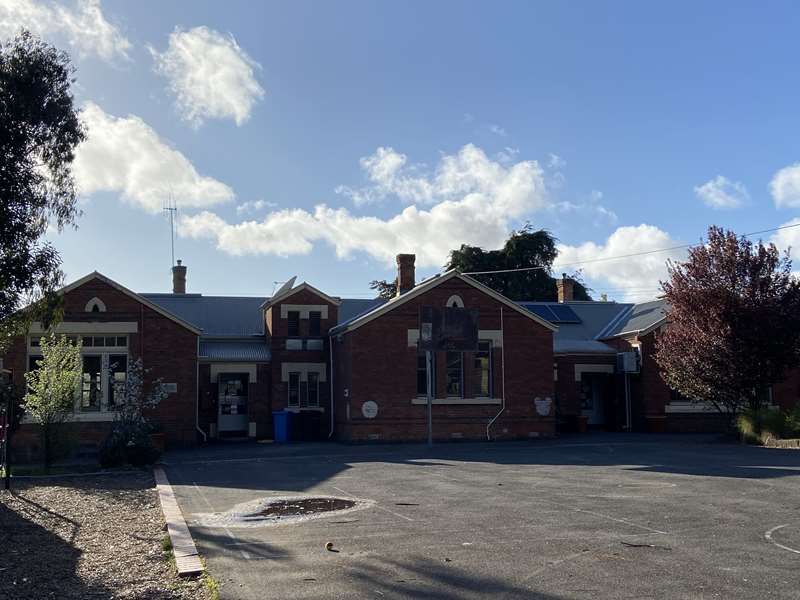
6. TARADALE RAILWAY VIADUCT (i)
This imposing structure, listed on the Victorian Heritage Register, was constructed between 1858-1862. It rises 36 m above Back Creek and is 198 m long. Pay disputes and strikes and even a march to Woodend in 1861 marked worker dissatisfaction and at least four men died during construction. In May 1933, framed steel trusses were erected to reduce the stress on girders by the heavier locomotives. Workmen decorated the viaduct with festooned arches for the first train to travel through while twelve hundred people attended and celebrated the opening in October 1862.
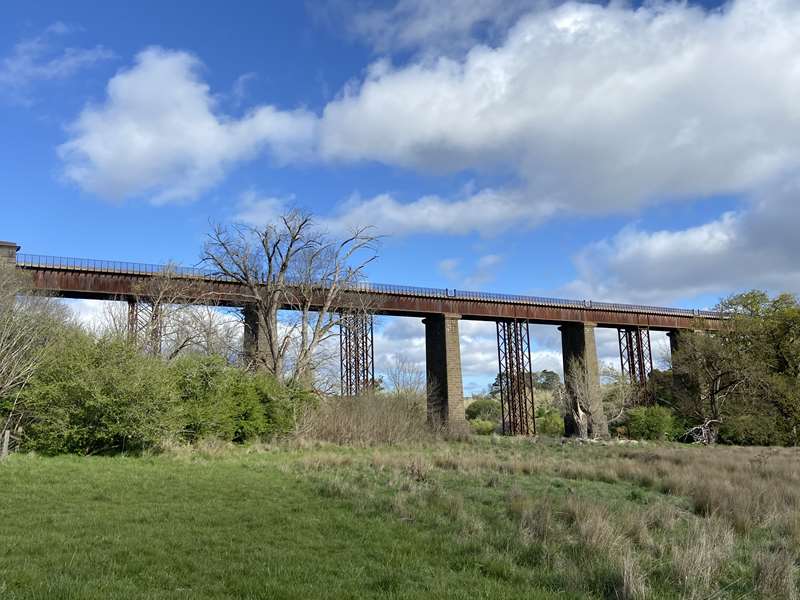
7. BARKLY PARK
Barkly Park is situated to the east of Taradale Viaduct. Originally comprising 108.5 acres (44 ha) annexed from the survey paddock, it was reserved for public purposes in January, 1858 and gazetted as a park in October, 1861. In approximately 1935 the Park was reduced to 38 acres (15 ha) and a nine-hole golf course was constructed. The Taradale Golf Club hosted regular matches and an annual championship, the last of which was held in 1958. Two 'Royal Oaks' were planted in the Park in 1863.
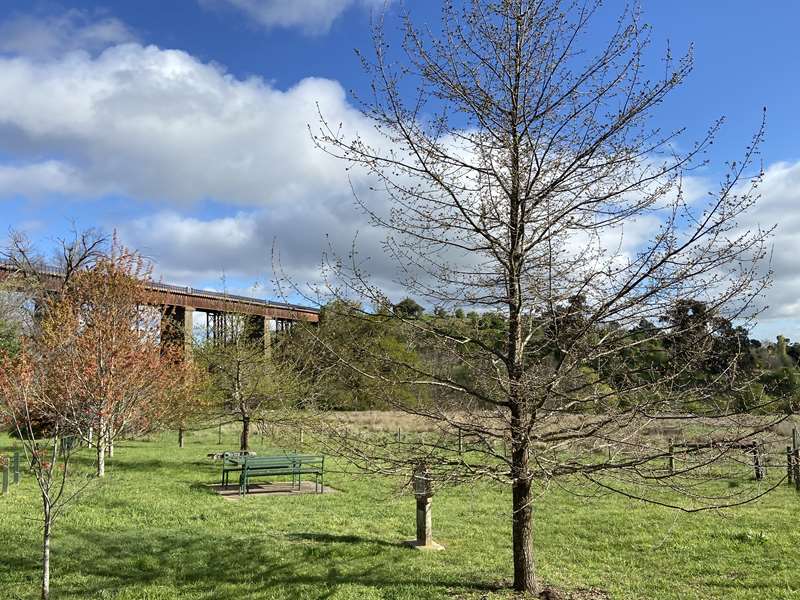
8. RAILWAY STATION (i)
The line from Kyneton to Bendigo was opened for passengers in October 1862 and for goods in March 1863. The bluestone buildings consist of an office, waiting room and a two-storey residence. The goods shed is of unique design with fine details. The ornate verandah was demolished in the 1960's despite local objections. Taradale Station is a substantially intact example of an early high-standard Victorian Railways building. It is now privately leased.

9. KING BILLY BRIDGE
At the end of Wickham Street, leading to Hoods Track you will find King Billy Bridge. The bridge was constructed c 1880 and was originally the site of the Achilles Gully Footbridge. It was restored in 1996 by volunteers from the Taradale and District Walking and Landcare Group.
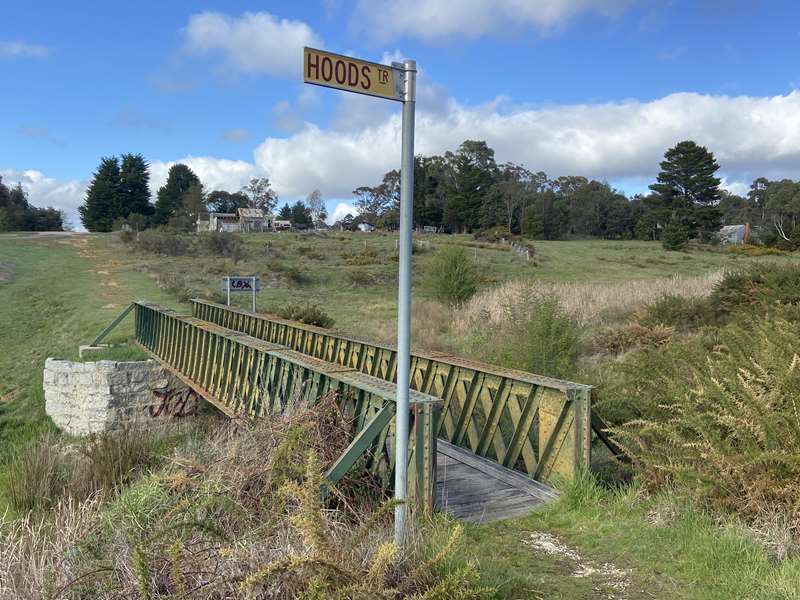
10. QUARTZ BATTERY The corrugated iron shelter belies the powerful equipment inside. The Taradale Quartz Battery was established in 1932, being works moved from their original site in Maldon for the Proteus Gold Mining Company (Picken and Dorman's North Phoenix Mine). The equipment was designed to crush four tonnes of ore per shift and was closed in 1957. A viewing point at the rear allows the crushing equipment to be seen.
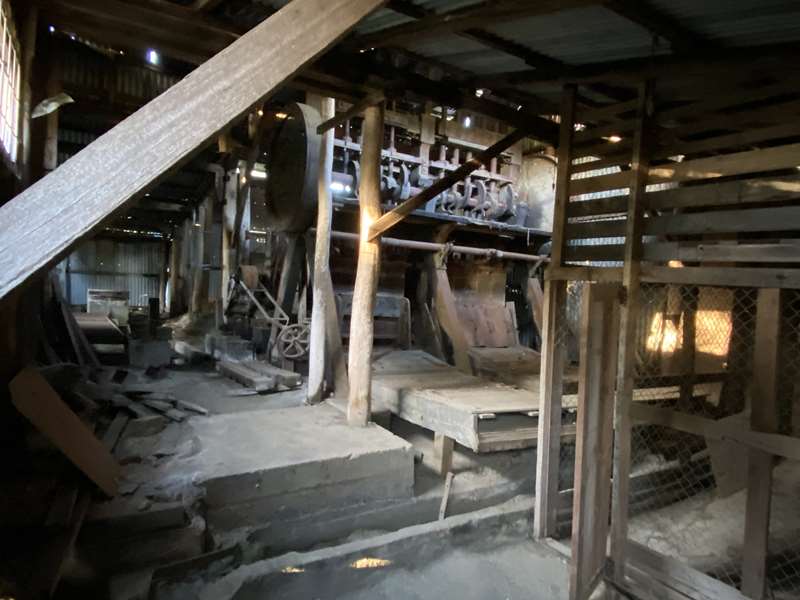
(i) Historical information board at this location
Photos:
Location
High Street, Taradale 3447 View Map








